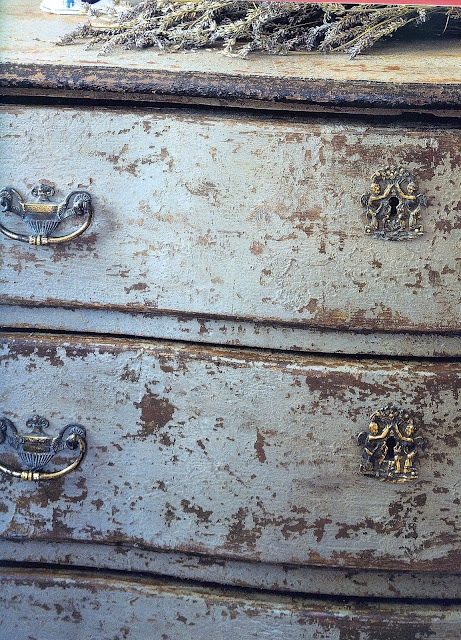We have always wanted to do a series on “Making Patina.” Detailed step-by-step instruction, videos, and other great resources from the web as well as inspiration photos showing you different ways you can upcycle your furniture to look like an antique.
So often we see furniture that we can paint, or add Efex embellishments, to get that aged look. But the tricky part is often where to start. We’re providing you a simple road map to help you take that first step.
As you follow this series you will be amazed at how easy it really is to get the aged feel like you see in two of our favorite blogs, Velvet and Linen and Tone on Tone. On the web, especially Pinterest and Instagram, you can find all sorts of great examples of patina.

What is patina?
Michael Flanigan, an Antiques Roadshow appraiser, says, “Patina is everything that happens to an object over the course of time. The nick in the leg of a table, a scratch on a table top, the loss of moisture in the paint, the crackling of a finish or a glaze in ceramics, the gentle wear patterns on the edge of a plate. All these things add up to create a softer look, subtle color changes, a character. Patina is built from all the effects, natural and man-made, that create a true antique.”
So there is the definition, but this only begins to cover what patina is. Patina is a feeling of age. It hints at worn elegance, a life well lived and well cared for. It harkens back to a slower pace of life when everything was repurposed or reused instead of replaced.
During this miniseries we are going to view patina though the eyes of a decorative painter. There are many ways to achieve the look, but we have broken them down into four easy segments.
1- Chipping and Cracking
2- Layering
3 – Worn by Time: the fine art of sanding and waxing
4 – Faded Glory – aging gilding
Chipping and Cracking
Chipping and cracking are not exactly the same even though they can often occur together. With time old paint can chip off showing the undercoat or past paint jobs. It can also form hairline cracks in the surface of the paint. In our first series, Chipping and Cracking, we will show several painting techniques as well as crackle products to get the illusion of age that makes something look so beloved.
We will explore three different painting techniques using a resist where the resist medium keeps the second coat of paint from adhering to the undercoat. We will be using hemp oil and wax and a surprise ingredient “crud” as our resist agents. Then we will show you how to use cracking products to get a fine cracked surface.

Layering

Layering is multiple layers of paint on a surface. These layers can be of contrasting colors, or more subtle shades of paint that are often used to show shadows and highlights. There are so many layering techniques that it’s almost hard to know where to start.
In our series we will begin with a simple two color layered distressed finish, then move on to three special layering variations designed to add texture and pull out highlight and shadows.
1 – Two Color Distress
2 – Wet on Wet
3 – Dry Brushing
4 – Incomplete Mixing
Worn by Time
Over time furniture ages and is worn smooth by handling. We can help new pieces achieve this look with sanding and waxing. By sanding you can make a surface look dinged and rough, or it can simply add a smooth feel. Waxing, on wood or painted surfaces, both protects the surface and adds to that soft burnished texture. There is a special feel that only a waxed surface can achieve. You will be amazed at how much patina you can get with sanding and waxing. One of our tutorials includes an in-depth explanation of how to use dark wax correctly.
Faded Glory

Historically many styles of furniture have added gilding to highlight special embellishments or edges. Of course over time this fades to a dull and wonderful surface. Just adding gilding is great if you want sparkling bling, but often what you’re really after is that aged look.
Our segments on faded glory will focus on using
1 – Gilding Wax
2 – Foils
3 – Leaf
All of these have a few extra twists and tips to make the aging process easy and fun. They are all great ways to add faded glory.
Please join us over the next few weeks to see how to get each of these looks using a variety of techniques and products. While we are going to show you each method step-by-step, there is really no right or wrong way. And as a bonus you can always mix and match techniques to make the finish uniquely yours. And all of these techniques can be done with, and over, Efex Moldings to bring out the details.
Caio, until next time when we start looking at the chipping and cracking.
XOXO
Lydia


Cant wait for the series to begin!
very excited Thanks x